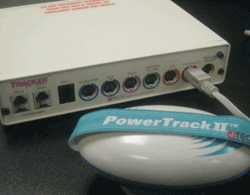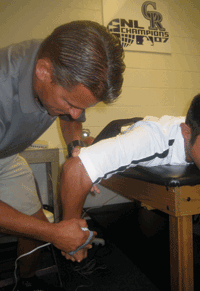Professional pitchers with weak shoulders in the preseason prone to in-season injuries
The subjects studied also sustained various shoulder injuries when they had reduced supraspinatus or external/internal rotation strength in the preseason.
|
|
In-season throwing-related injuries in professional baseball pitchers are associated with weakness in the preseason of external rotators and reduced supraspinatus strength, according to a multicenter study presented at the 2010 Annual Meeting of the American Academy of Orthopaedic Surgeons in New Orleans.
“We found that shoulder external rotator and supraspinatus weakness are significantly associated with throwing-related injury requiring surgical intervention. The ratio of external to internal rotation strength is also associated with incidence of shoulder injury and trends toward association with that of any throwing-related injury,” Ian R. Byram, MD, of Vanderbilt University Medical Center, in Nashville, said.
Because shoulder injuries in professional baseball players result in lost playing time, Byram and colleagues examined the relationship between preseason shoulder strength and subsequent injuries. He said this is an area that had rarely been studied.
|
Images: Byram IR |
“We hypothesized that preseason weakness of shoulder external rotators would be associated with increased risk of in-season throwing-related injury in professional baseball pitchers,” he said during his presentation.
Four tests
The investigators identified 144 major and minor league baseball players within the same organization who pitched over a 5-year period. The subjects participated in annual, standardized preseason strength tests performed with a hand-held dynamometer by a single athletic trainer. Because several players remained with the organization for more than 1 year, 207 data points were collected for analysis.
The four strength tests performed were prone internal rotation, prone external rotation, seated external rotation and supraspinatus. Investigators calculated the ratio of prone external to prone internal rotation strength for each of the players and followed them during the playing seasons to track any injuries that warranted placement on the disabled list.
|
|
“We recorded the type of injury and method of treatment,” Byram noted.
Researchers categorized each season injury variable as 0 for no injury, 1 for an injury not requiring surgery and 2 for an injury requiring surgery.
Analysis results
When the investigators analyzed the associations between strength and injuries, they found that prone external rotation, seated external rotation and supraspinatus strength were associated with pitching-related injury requiring surgery.
A subset analysis of shoulder injuries also revealed an association between weakness of external rotators and supraspinatus and likelihood of injury requiring surgery. “We saw an association between the ratio of external/internal rotation strength and likelihood of shoulder injury, and there was a trend toward association between this ratio and any throwing-related injury,” Byram said.
He noted the study’s conclusions are limited by the fact it did not consider statistics like pitch count, throw velocity and whether subjects were starter or relief pitchers.
Byram said the study results may help sports medicine physicians and trainers identify those players who are at risk for injury. – by Susan M. Rapp
Reference:
- Byram IR, Bushnell BD, Dugger K, et al. Preseason shoulder strength measurements can predict injury in professional baseball pitchers. Paper #32. Presented at the 2010 Annual Meeting of the American Academy of Orthopaedic Surgeons. March 9-13, 2010. New Orleans.
Ian R. Byram, MD, can be reached at Vanderbilt University Medical Center, 1211 Medical Center Drive, Nashville, TN 37232; 615-936-3391; e-mail: ian.byram@vanderbilt.edu.
Shoulder injuries requiring surgery in throwing athletes are typically season ending and often put the athlete’s career at risk. Therefore the ability to recognize or screen a throwing athlete at risk for such an injury and then institute a prevention strategy has tremendous value. This study has successfully associated preseason rotator cuff weakness with in-season shoulder injuries requiring surgery over a 5-year study period in professional pitchers. This study therefore, clearly establishes the importance of rotator cuff function in protecting the shoulder from injury.
While this study highlights the rotator cuff, other factors contributing to shoulder injury must also be considered and investigated. The throwing motion is a complex event involving a kinetic chain interaction of the lower extremity, trunk, torso, and upper extremity including scapulothoracic mechanics. It is therefore simplistic to analyze the rotator cuff in isolation. Overall, I believe this study has clinical impact and will stimulate more regimented and disciplined rotator cuff conditioning programs for throwing athletes of all skill levels and will further stimulate research to identify other modifiable factors involved in shoulder injury.
– Christopher S. Ahmad, MD
Director
Pediatric and Adolescent Sports Medicine
Associate Professor
Department
of Orthopaedic Surgery, Columbia University



